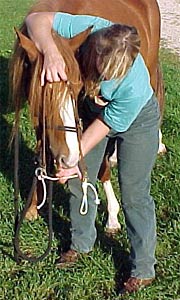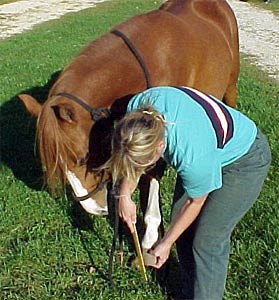|
Clipping and Bridling Your Horse By Tracy Porter
Without Drawin' Blood or Beatin' Yer Hoss!
When I was a little girl I couldn't stand getting my hair cut around my ears. I was convinced my mom picked the pixie cut…just to
torment me. To add insult to injury… that cut and my name, no one knew if I was a boy or a girl. I feel the scars to this day, okay, not
really. I was just trying to add an emotional element to my sad little story. Back to my ears, each time they would get those scissors
cutting in the direction of my ears, I could feel those cold metal blades snipping off the tips of my ears! I would kink my head as they
snipped, trying to avoid looking like Vince Van Gogh. Of course it took twice as long since I kept moving my head in defiance.
I can't say that de-worming caused me any problems but there are a few stories that hit the rumor mill that when I was 10 a nurse
chased me around the table trying to give me a measles shot, she called my mom in for assistance. After that, examining tables were
moved against the walls. But if that wasn't enough you should have been there when I went thru allergy shots, every week I went in
and they would bring out a metal box with at least 50 syringes with HUGE LONG NEEDLES! EEK! The treatments went on for
years! Trying to get over my needle phobia, recently I was able to successfully give blood at the Red Cross blood drive. I was trying
to blend in with the rest of the regulars until I shot off the lounge chair from the first "prick" I felt. Actually the nurse was drawing spots
on my arm with an ink pen. She suggested I come back another year and watch or better yet, serve cookies to the donors. I firmly
told her NO, if I left, I would never make it back in the door. One half pint of blood later, I queasily got up and they assisted me to
wait at the table only to find my mother totally astonished that I was there when she saw my name on the top of the sign in list.
Apparently my nervousness also caught the attention of the cookie patrol and they gave me two heart stickers, one was for bravery.
I had this chronic bronchitis thing going until I was about 6 years old. I'd actually roll off my bed and hide next to the bed and the wall
to avoid taking my cough medicine. I admit that to this day I still have to have someone give me the medicine and still have a chaser of
grape juice to follow. Before you think I am a physicians worst nightmare, I've always loved going to the dentist. I have my own kind
of bridling problems, clothes. I like wearing them, just not shopping for them.
So, now you know how qualified I am to teach you how to get your horse over phobic behaviors! I am a survivor of many years myself and have many future years ahead of me!
Although my problems really are not related and I seemed to have suffered from them all from the horse's perspective if they have one,
there's a good chance that there will be issues in the other areas as well. But if you just have one problem, GREAT! But don't get to
comfortable because that one deep rooted problem that can cause you a lot of grief. How do we attack our problem? How else, but with a well defined lesson plan!
First let's look at the 'root' of the problem. The clipper, bit, de-worming tube or dental instruments represent a level of pressure that the horse can't handle.
Instead of starting with what he can't handle, we need to look for the level the horse can comfortably handle.
To find this comfort level, the horse needs to be comfortable with us in his territory…. walking up to him, rubbing him all over
with our hands. We don't want to just focus on his face. We then can teach him to drop his head and give his nose. This "giving" also
represents increased levels of pressure. With practice, the horse will eventually be comfortable leaving his head down and his nose to
the side. We want the horse to enjoy this relaxed place as it's where we want his head, to halter, bridle, de-worm, clip, medicate, etc..
When your horse drops his head, he is learning to give to pressure. We can practice this when he's standing or when we're leading
him. To improve our horse's level even further we can ask him to drop his head while leading him in different locations, with different
distractions all the while practicing his standing and walking skills. Long term, this will improve your horse's handle ability and your horse will be envied by your friends!
But let's get back to the fact that we want to de-worm, bridle or whatever. How do we keep moving toward our goal? Rummage.
What? Where? Simple, look around your barn and house for many different items that you can rub all over your horse. You want a
variety of items, the first ones you use should be non threatening, ones that will be easy for your horse to deal with and eventually
progressing to the specific item or skill that's been the big boogie. Examples of items you will want to include are de-worming tubes
(clean them out), paint stirrer sticks, towels, sponges, tinfoil, plastic bags, scratchy pads, feather duster, tube socks. Be creative.
A few basic rules. Arrange and present these things to your horse in a progression from easy to hard. But first begin with your
hands. Your horse has to be comfortable with your hands before using the first item, and you can add in noises, blowing and kisses as
you sack out with your hands. Keep in mind though your horse needs to be comfortable before you get your face close to his if you
want to avoid a bloody nose. Then pick up your first easy item. Your horse will most likely act like it is no big deal.
Don't quit there, before grabbing the next add a little extra oomph by making noises, kisses and blowing air. Eventually you will get
thru the entire series and your horse's confidence level will mature along the way, until you reach your goal.
Many of the things that we require of our horse are something we may not have the opportunity to do everyday. But never fear, here
are some tips for training in between those times and your horses consistency will get even better.
 Bridling. Don't practice with a bit. Bridling. Don't practice with a bit.
You can sack the horse out with the noise and the head stall hanging off his ears. But only put the bit in
once and leave it there until you're finished with the session and are ready to take it off. Before this
momentous occasion, practice with a half inch diameter rope attached to a head stall or just use a big
loop. This will allow you to practice and perfect your technique, it also allows the horse to get more comfortable and avoids bumping the metal bit on his teeth.
De-worming. Add a last step. Applesauce or molasses taste great and wear even better. Find
out which your horse will lick out of a bucket and fill your empty de-worming syringe with it. Make
sure the stuff is slopped over the tube. Everyday that you can after catching and grooming your horse,
give him a treat with the syringe. Soon he will be sucking it out of the tube before you get to push the
plunger in! When the day comes for the de-wormer. It should go smoothly! You can even put a little of the good stuff on the outside of the syringe if it makes you feel better.
Clipping. Get a battery operated unit. First massage the horse over its whole body with the clipper
off. Then go across the room and turn it on for a split second and build till you can leave it run for a bit. Next walk toward the horse
messing with the clipper with no intention of touching the horse. Remember, if this is as close as you can get with the clipper running
fine, build on this OR back up. But if you've done every step well you will be massaging your horse in no time turning the clipper on
and off. The first time "don't plan to get your horse clipped"! Just massage, clip some hair, massage and then clip some more hair.
Continue each day with the same sequence. Your horse will begin to enjoy the massaging. You can also get a little battery operated
hand massager that will not only feel good, but add a new element of noise.
Be sure to frequently clean and oil your clipper, don't let it get hot and make sure those blades are sharp. Nothing worse than dull blades that snatch and jerk each hair out by the root!
 Teeth. Want your vet to love you? Handle your horse's mouth, lips and tongue
frequently. Check your horse's capillary refill time so you know what is normal. Take a new paint stirrer stick and practice putting it in your horse's mouth, a bit of
molasses will make it even tastier. Teeth. Want your vet to love you? Handle your horse's mouth, lips and tongue
frequently. Check your horse's capillary refill time so you know what is normal. Take a new paint stirrer stick and practice putting it in your horse's mouth, a bit of
molasses will make it even tastier.
Finally, use it just like the vet uses her floating tools.
 Gee whiz, you can also use it as a rasp, pick up his foot and rub it on the hoof and then your farrier will love you, too! Gee whiz, you can also use it as a rasp, pick up his foot and rub it on the hoof and then your farrier will love you, too!
The key is that you are convinced that your horse is going to succeed. Don't change or lower your expectations or your horse will wonder what's up! By this time, he's the
best horse ever was and he belongs to you…just be sure to let him know it.
|